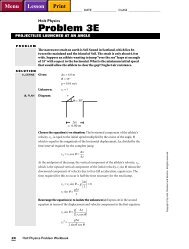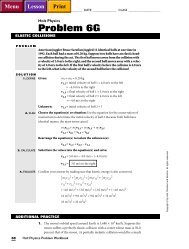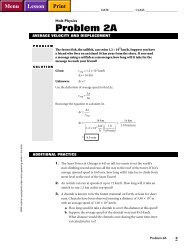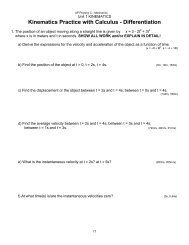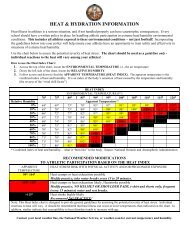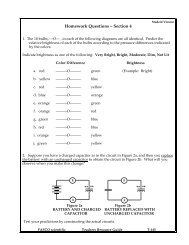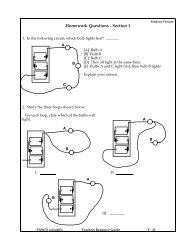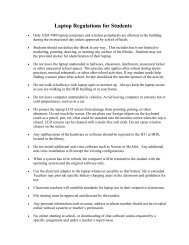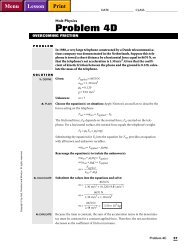Holt Physics Problem 2D - Hays High School
Holt Physics Problem 2D - Hays High School
Holt Physics Problem 2D - Hays High School
You also want an ePaper? Increase the reach of your titles
YUMPU automatically turns print PDFs into web optimized ePapers that Google loves.
NAME ______________________________________ DATE _______________ CLASS ____________________<br />
10<br />
3. CALCULATE<br />
4. EVALUATE<br />
ADDITIONAL PRACTICE<br />
Substitute the values into the equation(s) and solve:<br />
<strong>Holt</strong> <strong>Physics</strong> <strong>Problem</strong> Workbook<br />
∆t =�� = �� =<br />
1.2 m<br />
⎯<br />
0.32 m/s 2<br />
(2)(0.60 m)<br />
⎯⎯<br />
0.20 ⎯ m<br />
s2⎯ + 0.12 ⎯m<br />
s2⎯ 1.9 s<br />
The final speeds for the first and second cockroaches are 0.38 m/s and 0.23 m/s,<br />
respectively. Both of these values are well below the maximum speed for cockroaches<br />
in general.<br />
1. In 1986, the first flight around the globe without a single refueling was<br />
completed. The aircraft’s average speed was 186 km/h. If the airplane<br />
landed at this speed and accelerated at −1.5 m/s 2 , how long did it take<br />
for the airplane to stop?<br />
2. In 1976, Gerald Hoagland drove a car over 8.0 × 10 2 km in reverse. Fortunately<br />
for Hoagland and motorists in general, the event took place on<br />
a special track. During this drive, Hoagland’s average velocity was<br />
about –15.0 m/s. Suppose Hoagland decides during his drive to go forward.<br />
He applies the brakes, stops, and then accelerates until he moves<br />
forward at same speed he had when he was moving backward. How<br />
long would the entire reversal process take if the average acceleration<br />
during this process is +2.5 m/s 2 ?<br />
3. The first permanent public railway was built by George Stephenson<br />
and opened in Cleveland, Ohio, in 1825. The average speed of the<br />
trains was 24.0 km/h. Suppose a train moving at this speed accelerates<br />
–0.20 m/s 2 until it reaches a speed of 8.0 km/h. How long does it take<br />
the train to undergo this change in speed?<br />
4. The winding cages in mine shafts are used to move workers in and out<br />
of the mines. These cages move much faster than any commercial elevators.<br />
In one South African mine, speeds of up to 65.0 km/h are attained.<br />
The mine has a depth of 2072 m. Suppose two cages start their<br />
downward journey at the same moment. The first cage quickly attains<br />
the maximum speed (an unrealistic situation), then proceeds to descend<br />
uniformly at that speed all the way to the bottom. The second<br />
cage starts at rest and then increases its speed with a constant acceleration<br />
of magnitude 4.00 × 10 –2 m/s 2 . How long will the trip take for<br />
each cage? Which cage will reach the bottom of the mine shaft first?<br />
5. In a 1986 bicycle race, Fred Markham rode his bicycle a distance of<br />
2.00 × 10 2 m with an average speed of 105.4 km/h. Markham and the<br />
bicycle started the race with a certain initial speed.<br />
a. Find the time it took Markham to cover 2.00 × 10 2 m.<br />
b. Suppose a car moves from rest under constant acceleration. What<br />
is the magnitude of the car’s acceleration if the car is to finish the<br />
race at exactly the same time Markham finishes the race?<br />
HRW material copyrighted under notice appearing earlier in this book.




